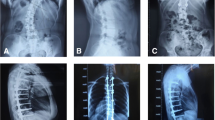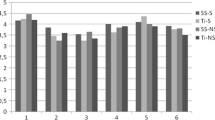Abstract
Purpose
Posterior-only approach arthrodesis by all-pedicle screw instrumentation has a correction rate similar to correction obtained by traditional combined anterior/posterior approach surgery and avoids the complications associated with the thoracic approach.
Methods
We treated 25 patients, with a mean age 16.5 years, with severe adolescent idiopathic scoliosis by posterior-only approach using all-screw instrumentation arthrodesis. Mean scoliosis curve in Cobb degrees was 95° Cobb. All cases were treated by the same senior surgeon, by free hand technique, without intraoperative neurophysiologic monitoring and spine navigation aids.
Results
Mean scoliosis curve after surgery was 37° Cobb. Mean follow-up was 4 years. No perioperative complications, curve progression or arthrodesis malunion were reported at the follow-up.
Conclusions
Posterior spinal fusion with pedicle screw-only instrumentation obtains a good and stable correction of severe scoliosis; compared to hybrid instrumentation, it allows a greater coronal correction of the deformity and less correction loss at the follow-up.




Similar content being viewed by others
References
Bullmann V, Halm HFH, Schulte T, Lerner T, Weber TP, Liljenqvist UR (2006) Combined anterior and posterior instrumentation in severe and rigid idiopathic scoliosis. Eur Spine J 15:440–448
Shufflebarger HL, Grimm JO, Bui V, Thomson JD (1991) Anterior and posterior spinal fusion. Staged versus same day surgery. Spine 16:930–933
Shen J, Qiu G, Wang Y, Zhang Z, Zhao Y (2006) Comparison of 1-stage versus 2-stage anterior and posterior spinal fusion for severe and rigid idiopathic scoliosis—a randomized prospective study. Spine 31:2525–2528
Kim YJ, Lenke LG, Bridwell KH, Kim KL, Steger-May K (2005) Pulmonary function in adolescent idiopathic scoliosis relative to the surgical procedure. J Bone Joint Surg Am 87:1534–1541
Arlet V (2000) Anterior thoracoscopic spine release in deformity surgery: a meta-analysis and review. Eur Spine J 9:S17–S23
Niemeyer T, Freeman BJ, Grevitt MP, Webb JK (2000) Anterior thoracoscopic surgery followed by posterior instrumentation and fusion in spinal deformities. Eur Spine J9:499–504
Newton PO, Marks M, Faro F, Betz R, Clements D, Haher T (2003) Use of video-assisted thoracoscopic surgery to reduce perioperative morbidity in scoliosis surgery. Spine 28:S249–S254
Bradford DS, Tribus CB (1997) Vertebral column resection for the treatment of rigid coronal decompensation. Spine 22:1590–1599
Suk SI, Chung ER, Kim JH, Kim SS, Lee JS, Choi WK (2005) Posterior vertebral column resection for severe rigid scoliosis. Spine 30:1682–1687
Arlet V, Jiang L, Ouellet J (2004) Is there a need for anterior release for 70°–90° thoracic curves in adolescent scoliosis? Eur Spine J 13:740–745
Burton DC, Sarna AA, Asher MA (2005) The treatment of large(>70°) thoracic idiopathic scoliosis curves with posterior instrumentation and arthrodesis: when is anterior release indicated? Spine 30:1979–1984
De Giorgi G, Stella G, Becchetti S, Martucci G, Miscioscia D (1999) Cotrel-Duboysset instrumentation for the treatment of severe scoliosis. Eur Spine J 8:8–15
Kuklo TR, Lenke LG, O’Brien MF, Lehman RA, Polly DW, Schroeder BS (2005) Accuracy and efficacy of thoracic pedicle screws in curve more than 90°. Spine 20:222–226
Dobbs MB, Lenke LG, Kim YJ, Luhmann SJ, Bridwell KH (2006) Anterior/posterior spinal instrumentation versus posterior instrumentation alone for the treatment of adolescent idiopathic scoliotic curves more than 90°. Spine 31:2386–2391
Luhmann SJ, Lenke LG, Kim YJ, Bridwell KH, Schootman M (2005) Thoracic adolescent idiopathic scoliosis curves between 70° and 100°. Is anterior release necessary? Spine 30:2061–2067
Lenke LG, Kuklo TR, Ondra S, Polly DW (2008) Rationale behind the current State-of-the-Art treatment of scoliosis (in the pedicle screw era). Spine 33(10):1051–1054
Suk S, Kim JH, Kim SS, Lim DJ (2012) Pedicle screw instrumentation in adolescent idiopathic scoliosis (AIS). Eur Spine J 21:13–22
Min K, Sduzy C, Farshad M (2013) Posterior correction of thoracic adolescent idiopathic scoliosis with pedicle screw instrumentation: results of 48 patients with minimal 10-year follow up. Eur Spine J 22(2):345–354
Di Silvestre M, Bakaloudis G, Lolli F, Vommaro F, Martikos K, Parisini P (2008) Posterior fusion only for thoracic adolescent idiopathic scoliosis of more than 80°: pedicle screws versus hybrid instrumentation. Eur Spine J 17:1336–1349
Crostelli M, Mazza O, Mariani M (2012) Free-hand pedicle screws insertion technique in the treatment of 120 consecutive scoliosis cases operated without use of intraoperative neurophysiological monitoring. Eur Spine J 21(Suppl 1):S43–S49
Modi HN, Suh SW, Hong JY, Yang JH (2010) Accuracy of thoracic pedicle screw using ideal pedicle entry point in severe scoliosis. Clin Orthop Relat Res 468:1830–1837
Kadoury S, Cheriet F, Beausèjour M, Stokes IA, Parent S, Labelle H (2009) A three-dimensional retrospective analysis of the evolution of spinal instrumentation for the correction of adolescent idiopathic scoliosis. Eur Spine J 18:23–37
Gang C, Haibo L, Fancai L, Weinshan C, Qixin C (2012) Learning curve of thoracic pedicle screw placement using the free-hand technique in scoliosis: how many screws needed for an apprentice? Eur Spine J 21:1151–1156
Sarlak AY, Buluc L, Sarisoy HT, Memisoglu K, Tosun B (2008) Placement of pedicle screws in thoracic idiopathic scoliosis: a magnetic resonance imaging analysis of screw placement relative to structures at risk. Eur Spine J 17:657–662
Suk SI, Kim JH, Cho KJ, Kim SS, Lee JJ, Han TY (2007) Is anterior release necessary in severe scoliosis treated by posterior segmental pedicle screw fixation? Eur Spine J 16:1359–1365
Conflict of interest
None.
Author information
Authors and Affiliations
Corresponding author
Rights and permissions
About this article
Cite this article
Crostelli, M., Mazza, O., Mariani, M. et al. Treatment of severe scoliosis with posterior-only approach arthrodesis and all-pedicle screw instrumentation. Eur Spine J 22 (Suppl 6), 808–814 (2013). https://doi.org/10.1007/s00586-013-3027-7
Received:
Revised:
Accepted:
Published:
Issue Date:
DOI: https://doi.org/10.1007/s00586-013-3027-7




